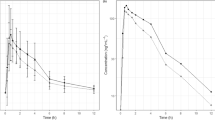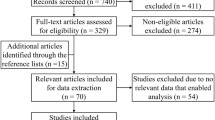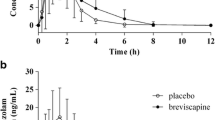Abstract
Objective
We studied the effects of gender and smoking on the pharmacokinetics and effects of the cytochrome P450 (CYP) 1A2 substrate tizanidine.
Methods
Seventy-one healthy young volunteers (male and female nonsmokers, male smokers) ingested 4 mg tizanidine. Plasma concentrations and pharmacodynamics of tizanidine were measured, and a caffeine test was performed.
Results
Among nonsmokers, the peak concentration (Cmax) and area under concentration-time curve from 0 to infinity [AUC(0-∞)] of tizanidine did not differ significantly between females and males. However, the half-life (t1/2) was 9% shorter in female nonsmokers than in male nonsmokers (P < 0.05). In male smokers, the t1/2 was 10% shorter and the weight-adjusted AUC(0-∞) 33% smaller than in male nonsmokers (P < 0.05). The caffeine/paraxanthine ratio was 35–40% smaller (P = 0.001) in male smokers than in nonsmoking males or females, but did not differ between males and females. Tizanidine lowered blood pressure and caused drowsiness significantly (P < 0.05) more in females than in either male groups. The effects on blood pressure were smallest in male smokers (P < 0.05).
Conclusions
Gender by itself seems to have no clinically significant effect on the pharmacokinetics of tizanidine, whereas smoking reduces plasma concentrations and effects of tizanidine. Any possible effect of gender and smoking is largely outweighed by individual variability in CYP1A2 activity due to genetic and environmental factors and in body weight. Careful dosing of tizanidine is warranted in small females, whereas male smokers can require higher than average doses.



Similar content being viewed by others
References
Relling MV, Lin JS, Ayers GD, Evans WE (1992) Racial and gender differences in N-acetyltransferase, xanthine oxidase, and CYP1A2 activities. Clin Pharmacol Ther 52:643–658
Fletcher CV, Acosta EP, Strykowski JM (1994) Gender differences in human pharmacokinetics and pharmacodynamics. J Adolesc Health 15:619–629
Meibohm B, Beierle I, Derendorf H (2002) How important are gender differences in pharmacokinetics? Clin Pharmacokinet 41:329–342
Gandhi M, Aweeka F, Greenblatt RM, Blaschke TF (2004) Sex differences in pharmacokinetics and pharmacodynamics. Annu Rev Pharmacol Toxicol 44:499–523
Bies RR, Bigos KL, Pollock BG (2003) Gender differences in the pharmacokinetics and pharmacodynamics of antidepressants. J Gend Specif Med 6:12–20
Rasmussen BB, Brix TH, Kyvik KO, Brøsen K (2002) The interindividual differences in the 3-demethylation of caffeine alias CYP1A2 is determined by both genetic and environmental factors. Pharmacogenetics 12:473–478
Schwartz JB (2003) The influence of sex on pharmacokinetics. Clin Pharmacokinet 42:107–121
Cotreau MM, von Moltke LL, Greenblatt DJ (2005) The influence of age and sex on the clearance of cytochrome P450 3A substrates. Clin Pharmacokinet 44:33–60
Morris ME, Lee HJ, Predko LM (2003) Gender differences in the membrane transport of endogenous and exogenous compounds. Pharmacol Rev 55:229–240
Niemi M, Pasanen MK, Neuvonen PJ (2006) SLCO1B1 polymorphism and sex affect the pharmacokinetics of pravastatin but not fluvastatin. Clin Pharmacol Ther 80:356–366
Parsons WD, Neims AH (1978) Effect of smoking on caffeine clearance. Clin Pharmacol Ther 24:40–45
Sesardic D, Boobis AR, Edwards RJ, Davies DS (1988) A form of cytochrome P450 in man, orthologous to form d in the rat, catalyses the O-deethylation of phenacetin and is inducible by cigarette smoking. Br J Clin Pharmacol 26:363–372
Kalow W, Tang BK (1991) Caffeine as a metabolic probe: exploration of the enzyme-inducing effect of cigarette smoking. Clin Pharmacol Ther 49:44–48
Vistisen K, Loft S, Poulsen HE (1991) Cytochrome P450 IA2 activity in man measured by caffeine metabolism: effect of smoking, broccoli and exercise. Adv Exp Med Biol 283:407–411
Rasmussen BB, Brøsen K (1996) Determination of urinary metabolites of caffeine for the assessment of cytochrome P4501A2, xanthine oxidase, and N-acetyltransferase activity in humans. Ther Drug Monit 18:254–262
Zevin S, Benowitz NL (1999) Drug interactions with tobacco smoking. An update. Clin Pharmacokinet 36:425–438
Tantcheva-Poor I, Zaigler M, Rietbrock S, Fuhr U (1999) Estimation of cytochrome P-450 CYP1A2 activity in 863 healthy Caucasians using a saliva-based caffeine test. Pharmacogenetics 9:131–144
Faber MS, Fuhr U (2004) Time response of cytochrome P450 1A2 activity on cessation of heavy smoking. Clin Pharmacol Ther 76:178–184
Faber MS, Jetter A, Fuhr U (2005) Assessment of CYP1A2 activity in clinical practice: why, how, and when? Basic Clin Pharmacol Toxicol 97:125–134
Petersen MS, Halling J, Damkier P, Nielsen F, Grandjean P, Weihe P, Brøsen K (2006) Caffeine N3-demethylation (CYP1A2) in a population with an increased exposure to polychlorinated biphenyls. Eur J Clin Pharmacol 62:1041–1048
Jokinen MJ, Olkkola KT, Ahonen J, Neuvonen PJ (2001) Effect of rifampin and tobacco smoking on the pharmacokinetics of ropivacaine. Clin Pharmacol Ther 70:344–350
Ursing C, von Bahr C, Brismar K, Röjdmark S (2005) Influence of cigarette smoking on melatonin levels in man. Eur J Clin Pharmacol 61:197–201
Rostami-Hodjegan A, Amin AM, Spencer EP, Lennard MS, Tucker GT, Flanagan RJ (2004) Influence of dose, cigarette smoking, age, sex, and metabolic activity on plasma clozapine concentrations: a predictive model and nomograms to aid clozapine dose adjustment and to assess compliance in individual patients. J Clin Psychopharmacol 24:70–78
Seppälä NH, Leinonen EV, Lehtonen ML, Kivistö KT (1999) Clozapine serum concentrations are lower in smoking than in nonsmoking schizophrenic patients. Pharmacol Toxicol 85:244–246
Gardner MJ, Tornatore KM, Jusko WJ, Kanarkowski R (1983) Effects of tobacco smoking and oral contraceptive use on theophylline disposition. Br J Clin Pharmacol 16:271–280
Grygiel JJ, Birkett DJ (1981) Cigarette smoking and theophylline clearance and metabolism. Clin Pharmacol Ther 30:491–496
Koch P, Hirst DR, von Wartburg BR (1989) Biological fate of sirdalud in animals and man. Xenobiotica 19:1255–1265
Granfors MT, Backman JT, Laitila J, Neuvonen PJ (2004) Tizanidine is mainly metabolized by cytochrome p450 1A2 in vitro. Br J Clin Pharmacol 57:349–353
Granfors MT, Backman JT, Neuvonen M, Ahonen J, Neuvonen PJ (2004) Fluvoxamine drastically increases concentrations and effects of tizanidine: a potentially hazardous interaction. Clin Pharmacol Ther 75:331–341
Granfors MT, Backman JT, Neuvonen M, Neuvonen PJ (2004) Ciprofloxacin greatly increases concentrations and hypotensive effect of tizanidine by inhibiting its cytochrome P450 1A2-mediated presystemic metabolism. Clin Pharmacol Ther 76:598–606
Backman JT, Karjalainen MJ, Neuvonen M, Laitila J, Neuvonen PJ (2006) Rofecoxib is a potent inhibitor of cytochrome P450 1A2: studies with tizanidine and caffeine in healthy subjects. Br J Clin Pharmacol 62:345–357
Karjalainen MJ, Neuvonen PJ, Backman JT (2006) Rofecoxib is a potent, metabolism-dependent inhibitor of CYP1A2: implications for in vitro prediction of drug interactions. Drug Metab Dispos 34:2091–2096
Harder S, Fuhr U, Staib AH, Wolff T (1989) Ciprofloxacin-caffeine: a drug interaction established using in vivo and in vitro investigations. Am J Med 87:89S–91S
Fuhr U, Wolff T, Harder S, Schymanski P, Staib AH (1990) Quinolone inhibition of cytochrome P-450-dependent caffeine metabolism in human liver microsomes. Drug Metab Dispos 18:1005–1010
Brøsen K, Skjelbo E, Rasmussen BB, Poulsen HE, Loft S (1993) Fluvoxamine is a potent inhibitor of cytochrome P4501A2. Biochem Pharmacol 45:1211–1214
Wang JS, Backman JT, Wen X, Taavitsainen P, Neuvonen PJ, Kivistö KT (1999) Fluvoxamine is a more potent inhibitor of lidocaine metabolism than ketoconazole and erythromycin in vitro. Pharmacol Toxicol 85:201–205
Kalow W, Tang BK (1991) Use of caffeine metabolite ratios to explore CYP1A2 and xanthine oxidase activities. Clin Pharmacol Ther 50:508–519
Backman JT, Granfors MT, Neuvonen PJ (2006) Rifampicin is only a weak inducer of CYP1A2-mediated presystemic and systemic metabolism: studies with tizanidine and caffeine. Eur J Clin Pharmacol 62:451–461
Granfors MT, Backman JT, Laitila J, Neuvonen PJ (2005) Oral contraceptives containing ethinyl estradiol and gestodene markedly increase plasma concentrations and effects of tizanidine by inhibiting cytochrome P450 1A2. Clin Pharmacol Ther 78:400–411
Holland DT, Godfredsen KA, Page T, Connor JD (1998) Simple high-performance liquid chromatography method for the simultaneous determination of serum caffeine and paraxanthine following rapid sample preparation. J Chromatogr B Biomed Sci Appl 707:105–110
Pickard CE, Stewart AD, Hartley R, Lucock MD (1986) A rapid HPLC method for monitoring plasma levels of caffeine and theophylline using solid phase extraction columns. Ann Clin Biochem 23(Pt 4):440–446
Dollery C (1999) Caffeine. In: Dollery C (ed) Therapeutic drugs. Churchill Livingstone, Edinburgh, pp C4–C6
Bebia Z, Buch SC, Wilson JW, Frye RF, Romkes M, Cecchetti A, Chaves-Gnecco D, Branch RA (2004) Bioequivalence revisited: influence of age and sex on CYP enzymes. Clin Pharmacol Ther 76:618–627
Oztekin S, Mavioglu O, Elar Z, Guven H, Kalkan S, Gurpinar T (2005) The effects of gender and menopause on serum lidocaine levels in smokers. Eur J Drug Metab Pharmacokinet 30:231–234
Bruno R, Vivier N, Montay G, Le Liboux A, Powe LK, Delumeau JC, Rhodes GR (1997) Population pharmacokinetics of riluzole in patients with amyotrophic lateral sclerosis. Clin Pharmacol Ther 62:518–526
Schrenk D, Brockmeier D, Mörike K, Bock KW, Eichelbaum M (1998) A distribution study of CYP1A2 phenotypes among smokers and non-smokers in a cohort of healthy Caucasian volunteers. Eur J Clin Pharmacol 53:361–367
Bock KW, Schrenk D, Forster A, Griese EU, Mörike K, Brockmeier D, Eichelbaum M (1994) The influence of environmental and genetic factors on CYP2D6, CYP1A2 and UDP-glucuronosyltransferases in man using sparteine, caffeine, and paracetamol as probes. Pharmacogenetics 4:209–218
Laine K, Palovaara S, Tapanainen P, Manninen P (1999) Plasma tacrine concentrations are significantly increased by concomitant hormone replacement therapy. Clin Pharmacol Ther 66:602–608
Acknowledgements
This study was supported by grants from the Helsinki University Central Hospital Research Fund, the National Technology Agency, and the Sigrid Jusélius Foundation, Finland. None of the authors has any financial or personal relationships that could be perceived as influencing the research described.
Author information
Authors and Affiliations
Corresponding author
Additional information
This study was supported by grants from the Helsinki University Central Hospital Research Fund, the National Technology Agency, and the Sigrid Jusélius Foundation, Finland.
Rights and permissions
About this article
Cite this article
Backman, J.T., Schröder, M.T. & Neuvonen, P.J. Effects of gender and moderate smoking on the pharmacokinetics and effects of the CYP1A2 substrate tizanidine. Eur J Clin Pharmacol 64, 17–24 (2008). https://doi.org/10.1007/s00228-007-0389-y
Received:
Accepted:
Published:
Issue Date:
DOI: https://doi.org/10.1007/s00228-007-0389-y




